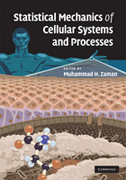
Cells are complex objects, representing a multitude of structures and processes. In order to understand the organization, interaction and hierarchy of these structures and processes, a quantitative understanding is absolutely critical. Traditionally, statistical mechanics-based treatment of biological systems has focused on the molecular level, with larger systems being ignored. This book integrates understanding from the molecular to the cellular and multi-cellular level in a quantitative framework that will benefit a wide audience engaged in biological, biochemical, biophysical and clinical research. It will buildnew bridges of quantitative understanding that link fundamental physical principles governing cellular structure and function with implications in clinicaland biomedical contexts. INDICE: 1. Concentration and crowding effects on protein stability from acoarse-grained model Jason K. Cheung, Vincent K. Shen, Jeffrey R. Errington and Thomas M. Truskett; 2. Observations on the mechanics of a molecular bond under force L. B. Freund; 3. Statistical thermodynamics of cell-matrix interactions Tianyi Yang and Muhammad H. Zaman; 4. Energy landscape theory of cellular networks Jin Wang; 5. Modeling gene regulatory networks for cell fate specification Aryeh Warmflash and Aaron R. Dinner; 6. Structural and dynamical properties of cellular and regulatory networks R. Sinatra, J. Gomez-Gardenes, Y. Moreno, D. Condorelli, L. M. Floria and V. Latora; 7. Statistical mechanics of theimmune response to vaccines Jun Sun and Michael W. Deem.
- ISBN: 978-0-521-88608-6
- Editorial: Cambridge University
- Encuadernacion: Cartoné
- Páginas: 215
- Fecha Publicación: 01/02/2009
- Nº Volúmenes: 1
- Idioma: Inglés
